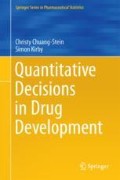Abstract
In this chapter, we give an overview of metrics that are useful to evaluate designs for determining if a new drug is efficacious at each of the three premarketing clinical development stages. The three stages are to determine if the new drug exhibits a positive proof of concept, to explore a possible dose-response relationship, and to confirm a hypothesized drug effect. The focus on efficacy is due to the generally well-defined endpoints to decide the beneficial effect of a new drug. Nevertheless, the approach is equally applicable to safety endpoints if there are specific safety endpoints that can be used to anchor design considerations and decision rules. Deliberations of the metrics for each stage will be further elaborated in Chaps. 7–9 respectively.
Without a standard there is no logical basis for making a decision or taking action.
Joseph M. Juran
Access this chapter
Tax calculation will be finalised at checkout
Purchases are for personal use only
References
Banerjee, A., & Christensen, J. (2015). Bayesian dose response. In S. M. Menon & R. C. Zink (Eds.), Modern approaches to clinical trials using SAS ® : Classical, adaptive, and Bayesian methods (pp. 225–246). Cary, NC: SAS Press.
Bornkamp, B., Bretz, F., Dmitrienko, A., et al. (2007). Innovative approaches for designing and analyzing adaptive dose-ranging trials. Journal of Biopharmaceutical Statistics, 17(6), 965–995.
Bornkamp, B., Pinheiro, J., & Bretz, F. (2009). MCPMod: An R package for the design and analysis of dose-finding studies. Journal of Statistical Software, 29(7), 1–23.
Brain, P., Kirby, S., & Larionov, R. (2014). Fitting Emax models to clinical trial dose-response data when the high dose asymptote is ill defined. Pharmaceutical Statistics, 13(6), 364–370.
Bretz, F., Pinheiro, J., & Branson, M. (2005). Combining multiple comparisons and modeling techniques in dose-response studies. Biometrics, 61(3), 738–748.
Burman, C. F., Grieve, A. P., & Senn, S. (2007). Decision analysis in drug development. In A. Dmitrienko, C. Chuang-Stein, & R. D’Agostino (Eds.), Pharmaceutical statistics using SAS ® : A practical guide (pp. 385–428). Cary, NC: SAS Institute.
Dunnett, C. W. (1955). A multiple comparison procedure for comparing several treatments with a control. Journal of the American Statistical Association, 50(272), 1096–1121.
FierceBiotech Report. (2010). The top 10 phase III failures of 2010. Accessed January 19, 2016, from http://www.fiercebiotech.com/special-reports/top-10-phase-iii-failures-2010#ixzz13Nwfm52q
Green, R. C., Schneider, L. S., Amato, D. A., et al. (2009). Effect of tarenflurbil on cognitive decline and activities of daily living in patients with mild Alzheimer disease: A randomized controlled trial. Journal of the American Medical Association, 302(23), 2557–2564.
Jones, B., Layton, G., Richardson, H., & Thomas, N. (2011). Model-based Bayesian adaptive dose finding designs for a phase II trial. Statistics in Biopharmaceutical Research, 3(2), 276–287.
MacDougall, J. (2006). Analysis of dose-response studies-Emax model. In N. Ting (Ed.), Dose-finding in drug development. New York: Springer.
Patel, N., Bolognese, J., Chuang-Stein, C., et al. (2012). Designing phase 2 trials based on program-level considerations: A case study for neuropathic pain. Drug Information Journal, 46(4), 439–454.
Pinheiro, J., Sax, F., Antonijevic, Z., et al. (2010). Adaptive and model-based dose-ranging trials: Quantitative evaluation and recommendations. Statistics in Biopharmaceutical Research, 2(4), 435–454.
Robertson, T., Wright, F. T., & Dykstra, R. L. (1988). Order restricted statistical inference. Hoboken, NJ: Wiley.
Ruberg, S. J. (1995a). Dose-response studies I: Some design considerations. Journal of Biopharmaceutical Statistics, 5(1), 1–14.
Ruberg, S. J. (1995b). Dose-response studies II: Analysis and interpretation. Journal of Biopharmaceutical Statistics, 5(1), 15–42.
Seber, G. A. F., & Wild, C. J. (2003). Nonlinear regression. Hoboken, NJ: Wiley.
Tan, H., Gruben, D., French, J., & Thomas, N. (2011). A case study of model-based Bayesian dose response estimation. Statistics in Medicine, 30(21), 2622–2633.
Thomas, N. (2006). Hypothesis testing and Bayesian estimation using a sigmoid Emax model applied to sparse dose-response designs. Journal of Biopharmaceutical Statistics, 16(5), 657–677.
Thomas, N., Roy, D., Somayaji, V., & Sweeney, K. (2014a). Meta-analyses of clinical dose response. Presentation at the European Medicines Agency/European Federation of Pharmaceutical Industries and Associations workshop on the importance of dose finding and dose selection for the successful development, licensing and lifecycle management of medicinal products. Accessed January 3, 2016, from http://www.ema.europa.eu/docs/en_GB/document_library/Presentation/2015/01/WC500179795.pdf
Thomas, N., Sweeney, K., & Somayaji, V. (2014b). Meta-analysis of clinical dose–response in a large drug development portfolio. Statistics in Biopharmaceutical Research, 6(4), 302–317.
Wang, M., Liu, G. F., & Schindler, J. (2015). Evaluation of program success for programs with multiple trials in binary outcomes. Pharmaceutical Statistics, 14(3), 172–179.
Wilcock, G. K., Black, S. E., Hendrix, S. B. et al., Tarenflurbil Phase II Study Investigators. (2008). Efficacy and safety of tarenflurbil in mild to moderate Alzheimer’s disease: A randomized phase II trial. Lancet Neurology, 7(6), 483–493.
Author information
Authors and Affiliations
Rights and permissions
Copyright information
© 2017 Springer International Publishing AG
About this chapter
Cite this chapter
Chuang-Stein, C., Kirby, S. (2017). Choosing Metrics Appropriate for Different Stages of Drug Development. In: Quantitative Decisions in Drug Development. Springer Series in Pharmaceutical Statistics. Springer, Cham. https://doi.org/10.1007/978-3-319-46076-5_6
Download citation
DOI: https://doi.org/10.1007/978-3-319-46076-5_6
Published:
Publisher Name: Springer, Cham
Print ISBN: 978-3-319-46075-8
Online ISBN: 978-3-319-46076-5
eBook Packages: Mathematics and StatisticsMathematics and Statistics (R0)

